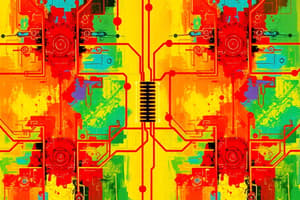Podcast
Questions and Answers
What is the purpose of biasing in a discrete MOSFET amplifier?
What is the purpose of biasing in a discrete MOSFET amplifier?
- To provide a stable operating point for the MOSFET (correct)
- To introduce distortion in the amplification process
- To increase the small signal gain of the amplifier
- To decrease the output impedance of the amplifier
In a CS configuration, what does the small signal voltage gain depend on?
In a CS configuration, what does the small signal voltage gain depend on?
- Frequency of the input signal
- Transconductance ($g_m$) of the MOSFET (correct)
- Biasing voltage applied to the gate terminal
- Output impedance of the amplifier
What is the effect of a current source load in a CS stage of a MOSFET amplifier?
What is the effect of a current source load in a CS stage of a MOSFET amplifier?
- Increases distortion in the output signal
- Decreases the input impedance and lowers the gain
- Improves the bandwidth but reduces the gain
- Increases the voltage gain and improves stability (correct)
What does cascading multiple amplifier stages primarily affect?
What does cascading multiple amplifier stages primarily affect?
What is a key advantage of using a cascode amplifier configuration?
What is a key advantage of using a cascode amplifier configuration?
Study Notes
MOSFET Amplifiers
- MOSFET circuits can be operated at DC
- MOSFETs can be used as amplifiers
- Discrete MOSFET amplifiers require biasing for operation
Biasing of Discrete MOSFET Amplifier
- Biasing is required to set the operating point of the MOSFET
- Proper biasing ensures the MOSFET operates in the desired region
Small Signal Equivalent Circuit
- The small signal equivalent circuit is used to analyze the amplifier's behavior
- The circuit is a simplified representation of the amplifier's AC behavior
Small Signal Voltage and Current Gain
- Small signal voltage gain is the ratio of output voltage to input voltage
- Small signal current gain is the ratio of output current to input current
- Both gains are important in determining the amplifier's performance
Input and Output Impedance of CS Configuration
- The common-source (CS) configuration has a high input impedance
- The CS configuration has a low output impedance
- These impedance values impact the amplifier's interaction with external circuits
CS Stage with Current Source Load
- A CS stage with a current source load provides a high output impedance
- This configuration is useful in certain amplifier applications
CS Stage with Diode-Connected Load
- A CS stage with a diode-connected load provides a low output impedance
- This configuration is useful in certain amplifier applications
Multistage Amplifiers
- Cascading multiple amplifier stages increases the overall gain
- Cascading multiple amplifier stages decreases the overall bandwidth
- The trade-off between gain and bandwidth must be considered in multistage amplifier design
Cascode Amplifier
- The cascode amplifier is a type of multistage amplifier
- The cascode amplifier provides high gain and high bandwidth
- The cascode amplifier is useful in applications requiring high performance
Studying That Suits You
Use AI to generate personalized quizzes and flashcards to suit your learning preferences.
Description
Test your knowledge on MOSFET circuits at DC, MOSFET used as an amplifier, biasing of discrete MOSFET amplifiers, small signal equivalent circuit, voltage and current gain, input and output impedance of CS configuration, CS stage with current source load, CS stage with diode-connected load, and multistage amplifiers including the effect of cascading on gain and bandwidth. Explore concepts like cascode amplifiers.




